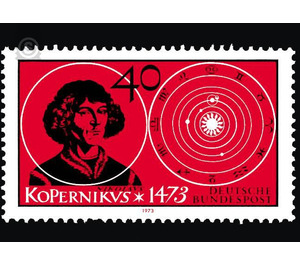500th birthday - Germany / Federal Republic of Germany 1973 - 40 Pfennig
Theme: Astronomy & Space
| Country | Germany / Federal Republic of Germany |
| Issue Date | 1973 |
| Face Value | 40.00 |
| Color | red |
| Perforation | K 14 |
| Printing Type | 2-color offset printing |
| Stamp Type | Postage stamp |
| Item Type | Stamp |
| Chronological Issue Number | 647 |
| Chronological Chapter | GER-BRD |
| SID | 965397 |
| In 44 Wishlists | |
Nikolaus Kopernikus, born in 1473 in Prussia, the son of a patrician of the Hanseatic city of Thorn, studied theology, mathematics, astronomy, law and medicine in Kulm, Krakow, Bologna, Padua and Ferrara and worked until the end of his life in 1543 in Frauenburg as canon of the Ermland cathedral chapter. Since its founding in 1243, the Hochstift Ermland has occupied a special position in Prussia: it was independent with the bishop and the cathedral chapter as sovereigns. For several years Copernicus, as "Administrator bonorum communium capituli Warmiensis," had to perform the functions of state sovereign in the chamber offices Olsztyn and Mehlsack. In this office he was also the fortress Olsztyn in the cavalry war between the Teutonic Knights and the Crown Poland. Often he took part as a representative of the cathedral chapter or on behalf of the bishop in the Prussian Diet. Several times he participated by appraisals and memoranda to the Prussian coin reform. Numerous recipes and notes bear witness to his medical work. In 1523, following the death of Bishop Fabian von Lossainen, the chapter transferred to him the general administration of Warmia for the Tent of the Veda. In 1537 he was on the candidate list for the Ermland Bishop chair. He gained immortal fame through the heliocentric system named after him, which replaced the old geocentric world view of Klaudios Ptolemy. The dethronement of the earth as the center of the universe had a revolutionary intellectual effect. At first, however, few people were able to mentally understand the change in the viewpoint demanded by Copernicus. Among the scholars a small band of open pendants was only gradually found. Kulmer Bishop Tidemann Giese and the Wittenberg mathematician Georg Joachim Rheticus have made a special contribution to the publication of the Copernican main work »De revolutionibus libri VI«. Astronomer Johannes Kepler, who comes from Weil der Stadt, replaces the orbits of the planets assumed by Copernicus with elliptical orbits; the Pisan scientist Galileo Galilei based his new conception of the world on his telescope observations of the Jupiter moons, and the English physicist, mathematician and astronomer Isaac Newton based the law of gravitation on the movement of the planets, thereby achieving the final victory of the Copernican system. Copernicus worked on his groundbreaking work "De revolutionibus libri VI" to the end of his life. Copernicus, independent of traditional heliocentric ideas, gained the common knowledge that the Earth and other planets are moving around the Sun only with Ptolemaic mathematics and ancient natural-philosophical assumptions. He took into account the decisive force of gravity of the fixed star parallax, which was not decisive for the heliocentric system, by assuming an infinite distance of the fixed stars. His determination of the distance of the planets finally overshadowed all the achievements of the most astute thinkers of antiquity and the Middle Ages. The first heliocentric draft "Commentariolus", drafted before 1514, is a concentric two-epicyclic system, the definitive doctrine presented in the "Revolutionibus" is an eccentric, one-pizyk system in which the center of the planetary orbits lies somewhat outside the sun. In 1535, Copernicus published a heliocentric almanac destined for the general public and now missing. Apart from his own and other astronomical observations, which are used by him in his main work, such are found in some of the books of the Frauenburg Dome Library which are kept in Sweden today. The original manuscript of the main work »De revolutionibus libri VI« now houses the Jagiellonian Library in Krakow. The first printed edition of the work was published in 1543 in the office of Johannes Petreius in Nuremberg. Of the extensive correspondence of Copernicus, only a good dozen letters have survived. In the stamp two juxtaposed motifs are used: a head-image reproduction of Nicolaus Copernicus and a representation of the Copernican world system. (Text: Werner Thimm)


